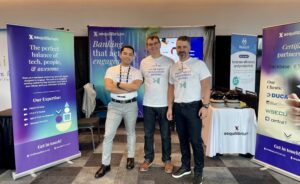In my career, I have experienced duality between my involvement in academia (both as a graduate student and a university professor) and my knack for the technology industry.
I started my career as a game developer for Ubisoft while working as an Assistant Professor of Computer Science, and pursuing my Master’s, simultaneously. After coming to Canada, I did my Ph.D. in Computer Science at SFU, while working as a full-time technical lead for ALI Tech (later renamed McKesson Medical Imaging after its acquisition).
I admire the concept of Applied Research, where you push the bar in research while immediately applying the learnings in the industry. In my case, with specialties in HCI and Usability, I focused on designing interfaces for radiology soft copy reading. Digitalization of the film radiology process was invented in 1918.
After scanning a patient through an imaging procedure, the images were printed in tile format on films, then hung in a particular order on light boxes, to be reviewed and interpreted by radiologists.
For example, it was demonstrated that, after re-engineering the workflow and integrating information systems, the process was reduced from 59 major steps to only 9 for an inpatient chest radiograph.
Similarly, in Architecture, Engineering, and Construction, XR provides immersive technology applications driving clear returns with tangible and scalable benefits.
An Introduction to XR
First, a quick recap on What is XR?
XR is the extended reality, an umbrella term that includes virtual, augmented, and mixed reality (Refer to Image 1):
- In Augmented Reality (AR) using transparent glasses you can view the reality, typically using digitally enhanced overlays, which enable context-sensitive interactions
- In contrast to AR, Virtual Reality (VR) provides a complete immersion (visual, audio, tactic tile, smell etc.) into a digital environment
- In Mixed Reality (MR), users interact with an environment consisting of both real and virtual worlds
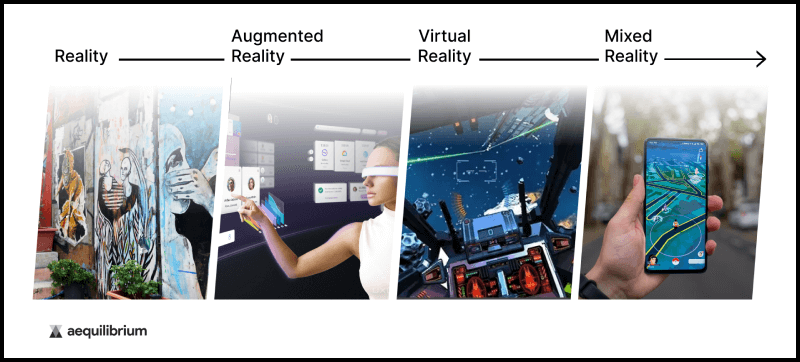
Image 1: Different Types of Realities – AR, MR, and VR
It is a collection of persistent virtual worlds and augmented reality (which brings digital enhancements to the physical world), typically multi-dimensional (3D, potentially enhanced with other types of sensory experiences, like touch, smell etc), and generally persistent, interactive, and social (Refer to Image 2).
These environments provide the most engaging experience when accessed via specialized or multi-sensory devices for VR or AR. They also work on other devices, like smartphones, tablets, glasses, etc.
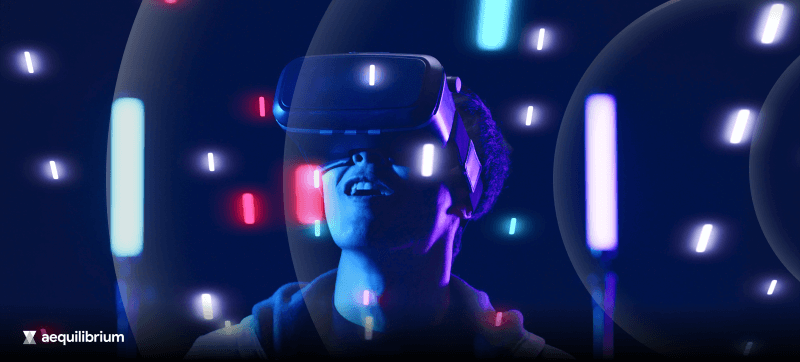
Image 2: The Metaverse
The metaverse is the next stage in the evolution of the internet, perceived as a $13 trillion a year opportunity. Over the period of time, it will affect all industries and companies, irrespective of geography or size.
Progressive companies are already acting, experimenting, and taking the lead on this gargantuan opportunity. Gartner reported that by 2026, 25% of people will be spending at least an hour a day in the metaverse for the purpose of work, shopping, education, socializing and/or entertainment.
Citi Research predicted that by 2035, half of the smartphone users could replace their phones with XR technologies. (Naik, 2021). The reason for this being, like the smartphone, XR devices and the metaverse will also revolutionize the way we interact, collaborate, communicate, and socialize. This change will manifest across all domains and industries in the near future.
What is AEC?
The full form of AEC is Architectural Engineering and Construction. The acronym describes the collaboration of architects, engineers, and construction professionals on residential, commercial, or industrial construction projects to ensure smooth completion of their projects.
These three disciplines are integral to the project from design to execution.
- Architecture: Architects design the concept for the construction, restoration, or refurbishment of buildings.
- Engineering: Engineers oversee the construction and maintenance of projects necessary in transforming concepts into reality.
- Construction: Construction project managers and their skilled laborers execute the design.
AEC is a growing global market and is expected to reach $10.5 trillion by 2023. Experts also expect it to grow at a compound annual growth rate of 4.2% between now and 2026. Additionally, the global AEC industry has experienced 40% annual revenue growth for 16 years straight. Historically, jobs in the industry have grown at 3.2% but were projected to grow by 5% in 2022 and then exponentially over the next few years.
AEC Problems, and XR Opportunities and Trends
Almost half of the major architectural firms across the globe use XR for design processes. The XR adoption has seen an exponential increase in the past few years, as XR enables the client to have a seamless and memorable user experience through its immersive 3D experience.
Rather than reading a plan or consulting drawings, XR offers an accurate insight of scale, depth, and spatial awareness for and to the clients. It helps clients to build more faith in the design process.
XR also enables seamless collaboration as it aids with tools to have all the stakeholders of the project, the contractors, engineers, and designers onboard, on the same page, and makes coordination more efficient.
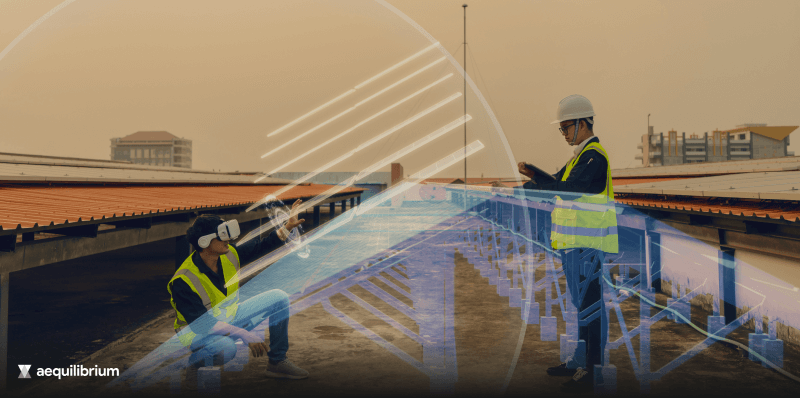
Image 3: XR in Construction
The Problem-to-Solve
- In the traditional two dimensional model, information is not fully understandable on a real scale. Ideally, the model can be enhanced by allowing people to feel the environment truly with sensory perceptions like the real feel of materials, positionings, lighting, and shadow to detail.
- During the global pandemic, the shortage of labor has been a big concern. This led to the rising cost. Employee turnover rose to 13.6% in 2021. Retaining skilled staff had been a challenge with most of the firms. Planning, training, and conceptualizing can save time, money and labor through the usage of XR.
- People involved with the AEC can not always be physically present at the field of work, therefore projects get delayed. XR can support remote work and provide platforms for collaboration from across the globe.
- Accessing data (current and old) and two dimensional models can be confusing and hectic. XR can host three dimensional models to real scale and can be accessed easily from anytime and anywhere with a centralized repository.
Opportunities
- VR technologies that incorporate BIM are used to support design, decision-making, education and training related to design and construction, and construction safety management.
- AR reduces rework and improves safety standards, lowers labor cost, and is time effective.
- MR has been used to aid designs to support construction education, construction assembly procedures, enhance collaboration and decision-making process, and also strengthen sustainability analysis.
Trends
- Green Process: A cost-effective and energy-efficient process with less carbon footprint, using which AEC professionals transform their processes.
- Data Management: Using green processes, data is collected on buildings to trace the health of facilities, and then it is used by the AEC team to improve the performance of the facility, save energy, and optimize space utilization.
- Remote Work enabled by AI: Real-time collaboration is possible within the metaverse with BIM using AI. Now people can work remotely and collaborate with people from across locations.
- Prefabricated Buildings: Modular buildings streamline the construction process by saving time. They also reduce activity on construction sites in accordance with social distancing trends.
- Automation and Robotics: Robots that can manage manual tasks, self-driving trucks, and materials by handling equipment that can be remotely operated, are making worksites safer.
- Facility Management: The digital twin or virtual representation of individuals is placed in facilities. Accessing dynamic live data, facility managers make decisions on day-to-day operations, manage technical processes involved in facilities and maintenance, and also detect system outages or failures.
- Building Renovations: Through smart investments using digital twins, buildings are inspected for renovation to achieve accurate predictions of renovations and repairs, ahead of time. This can be done by simulating environmental and building conditions by feeding data into a digital twin to estimate a proactive timeline for the implementation of renovations and repairs.
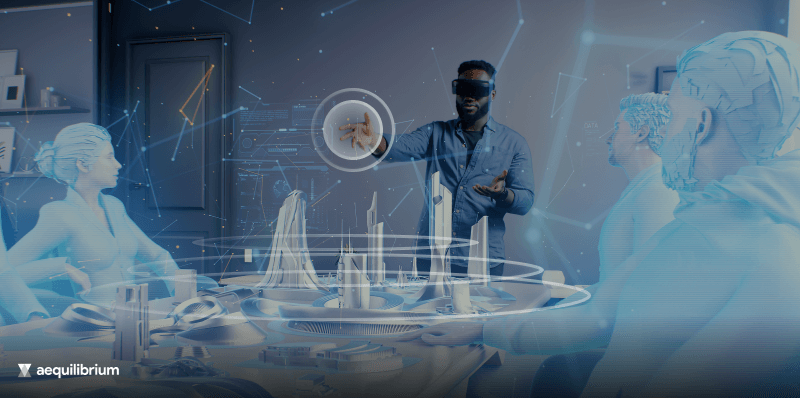
Image 4: XR in Civil Engineering
What does the future hold for AEC?
The global pandemic resulted in the loss of revenue and had a deep impact on the AEC industry. It is time to explore cutting-edge technologies by thinking outside the box for organizations that are trying to rise and shine.
Organizations may look for growth opportunities, new segments and locations to target and also plan cost and time effective solutions by migrating to Cloud or using collaborative platforms like BIM Level 2.
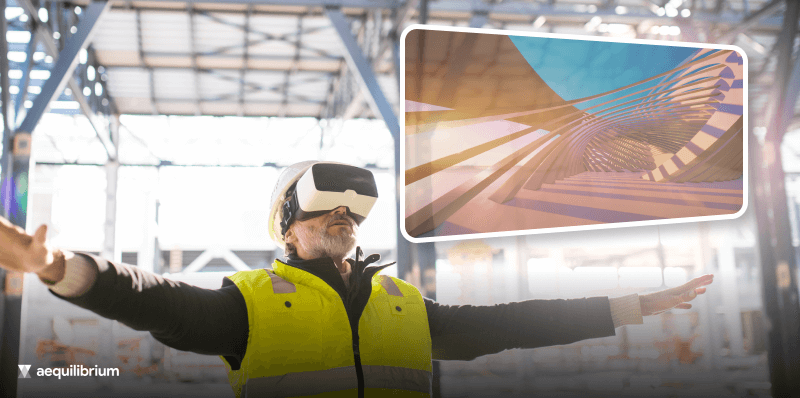
Image 5: XR in Architecture
XR Facilitating Collaboration for Distributed Teams
XR enables distributed teams to present, collaborate, and review projects together with immersive and interactive experiences, from anywhere and at any time.
Benefits of Architectural Firms
- Cost and time effective with presentations and approvals
- Better engagement and collaboration
- Enhanced decisions and outcomes
- Secure and high awareness regarding safety, access, and maintenance
- Better understanding of the projects and accelerated execution
- Seamless and memorable user encounters through immersive 3D experience
- Accurate insight of scale, depth, and spatial awareness delivered clients to develop faith in the design process
Learning from Case Studies:
- Henry Ford Museum of American Innovation streamlined design processes, expressed emotional look and feel, enhanced ergonomics, and identified errors early by building information management.
- Start in the digital space instead of having to create a digital twin after the construction is built.
- XR technologies immerse users through visuals, audio, and potentially olfactory and haptic touch cues.
Digital Twin in AEC
The digital twin is the virtual representation of an individual in the metaverse.
What are the benefits of digital twins?
The introduction of digital twins allows access to multi-dimensional views to derive how an asset is designed, and insights into its performance, such as traffic, space utilization, user patterns, preferences, and behavior.
Through digital twins, one can experiment and find sustainable data based on customized situations.
How do digital twins work?
A digital twin is integrated into the system of a building or facility via sensors and data matrix using advanced and digitized multidimensional models.
Highly defined digital twins are integrated with operational and behavioral components to simulate, predict, and react to situations based on real conditions.
How are digital twins used in BIM?
In the BIM process, data is absorbed from the initial phases of designing and planning. The usage of digital twins expands data capture to the next phases of construction and operations.
It can also be utilized to plan and design other projects in the future.
How can digital twins help with today’s challenges?
Traditionally AEC blueprints were made with 2D plans and people would spend long hours updating and distributing them. The BIM model makes the process seamless with cost and time-effective results. It is easy to maintain and manage facilities with predictive data and gain insights into scale, depth, and spatial details.
Conclusion
Progressive companies use XR in AEC to streamline design and review processes, reduce risks and costs associated with projects, and craft immersive brand experiences which convey the emotional look and feel and the ergonomics of the space.
Are you a progressive organization? Are you interested in using technology to craft remarkable experiences for your members and staff? Do you want more resilience, differentiation, and growth?
We’d be more than happy to organize a complimentary workshop to discuss your current status, objectives, and goals, and build a customized high-level strategy and tailored-to-fit digital roadmap for you.









